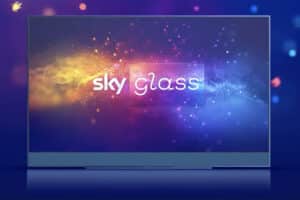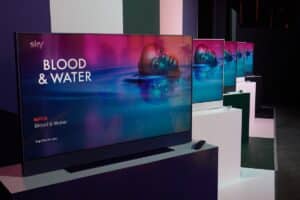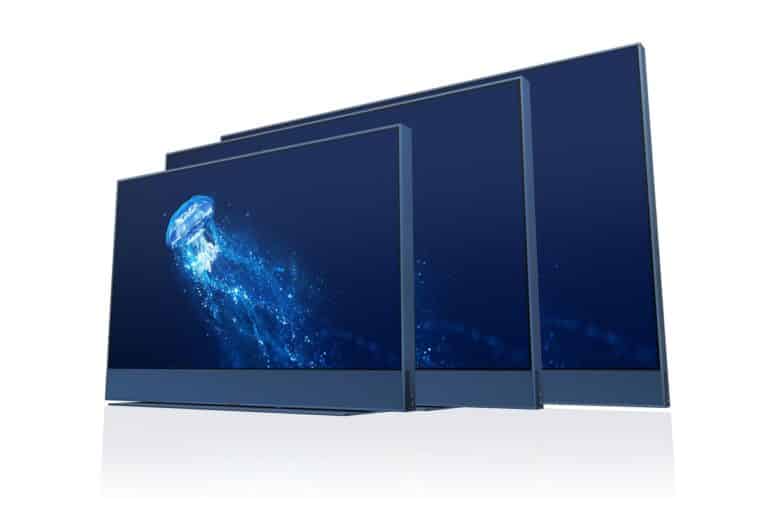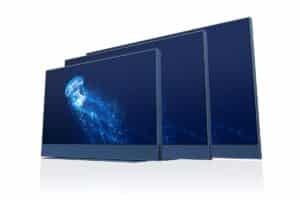Sky Glass is a 4K HDR television with a built-in Dolby Atmos soundbar giving you Sky TV without a satellite dish or cable box but also bringing a new interface.

Of course, promising a lot is one thing; the real question is whether Sky Glass delivers on its promises in terms of picture and sound quality, whether its streaming-based platform offers any benefits over a traditional Sky Q setup.
What you will see here:
Specs at a glance:
- Display type : UHD Quantum Dot
- Resolution: 3840 x 2160
- HDR: Dolby Vision®, HDR 10,HLG
- No of speakers : 6
- Audio format: Dolby Atmos
- Sound output: Up to 215 W
- Delivery: WiFi or Ethernet
- HD broadband speed required: 10Mbps
- UHD broadband speed required: 25Mbps
- Cables required : One power cable
- Channels supported : Up to 140 channels
- Apps supported : 21
- Voice control: Far-field voice detection
- Eco Features: Ambient light sensor
- HDMI : 3x HDMI 2.1
eARC and CEC supported - USB C: 1 (for power only – up to 15 W)
- TV Stand: Included
- Colors: Anthracite Black
Price: Sky Glass TV
Sky Glass is now available in three screen sizes in the United Kingdom: 43 (S), 55 (M), and 65 inches (L). They all have the same specifications, so no matter which screen size you choose.
The package will cost you £649 (43), £849 (55), or £1,049 if you buy it entirely (65). Sky does, however, provide the option of paying as part of a monthly Sky subscription, similar to a mobile phone contract.
Your TV can be paid for over a 24- or 48-month period with costs starting at £13/month for a 43-inch model, £17/month for a 55-inch model, and £21/month for a 65-inch model. Your chosen Sky subscription will be added on top of that, with the Sky Ultimate TV plan costing £26 per month (with Netflix included).
Availability
Sky Ultra HDR and Dolby Atmos will cost an extra £5 per month, plus further uplifts for Sky Sports (£25p/m), BT Sports (£24p/m), Sky Cinema (£11p/m), and Sky Kids (£5p/m).
The good news is that these are all on rolling 31-day contracts. This means you can change your contract every month to fit your needs. Furthermore, just like a smartphone, you’ll be able to upgrade your TV when a new model becomes available.
Design: Sky Glass TV
Sky Glass supports people with visual, hearing, cognitive, and physical impairments.
The Sky Glass is a nice-looking TV. But don’t expect it to have the same thin frame as the top 4K TVs like the LG C1 or Sony A80J. Instead, it’s a strikingly boxy design. Given that it has to fit a Dolby Atmos soundbar with six speakers within, this is understandable, but the overall impression is more practical than artistic.
There’s a built-in wall mount, or you can use the innovative stand to make it appear balanced on its bottom edge. The frame is made of aluminum alloy and comes in five colors: Ceramic White, Dusty Pink, Ocean Blue, Racing Green, or Anthracite Black. The stand and speaker grille can also be customized to match your preferred color.
It’s really simple to set up: simply connect to your Wi-Fi or connect through Ethernet, plugin, and that’s it. It’s a true one-cable solution (at least if you go wireless), allowing you to access a multitude of content with no effort and without the need for various streaming devices or remotes. However, you do get three HDMI 2.1 ports, making it simple to connect a PS5 or Xbox Series X, or one of the better streaming devices, if desired.
The ups and the downs:
Advantage:
Sky Glass is a broadcasting experience that requires some explanation.
It pulls stuff from the cloud and serves it out on-demand, rather than via satellite or cable. However, just going from BBC One to ITV is good; there’s hardly any buffering or delay, and you’d never guess it wasn’t coming from a Sky Q box.
Most of the channels you’d get with a Sky dish are available, but a couple isn’t; you’ll want to check Sky’s list in case one of your favorites isn’t there. The content from any streaming service is put in all these channels. You subscribe to, such as Netflix and Disney Plus, to create a cohesive picture.
It’s a flexible solution that puts a lot of stuff at your fingertips without forcing you to switch between apps all the time.
Disadvantage:
However, it does have one clear disadvantage over a hardware box: it lacks DVR functionality.
Sky Glass’ answer is to allow you to ‘Favorite’ episodes with a single click which adds them to your Playlist for easy retrieval later. Sky continues to refer to this as a “recording,” but it is not. It is nothing more than a bookmark to the on-demand video in question. As a result, if your Playlisted show vanishes from iPlayer or elsewhere before you can watch it, you’re out of luck.
Another disadvantage is that you can’t always rewind or start shows from the beginning when watching live TV. You can occasionally, but not always, and I haven’t been able to find a pattern. On a random Sunday afternoon, I was able to switch to episodes on Channel 4, 5, E4, Sci-Fi, and MTV. I watch them from the beginning — but not on BBC, ITV, Nat Geo, or Gold. Some Sky Sports channels allowed me to watch right away, while others did not.
It’s most likely connected to rights issues, and it’s a reasonable restriction. But it’s startling considering Sky Glass’s focus on creating a seamless experience.
Unique Interface
One of Sky Glass’ main selling points is its unique user interface, and after a few months of using it, I’m fascinated. It does a fantastic job of integrating numerous apps and services, providing you a much more unified view of what’s available than most platforms, including Roku and Samsung’s Tizen.
When you turn on the television, you’ll be bombarded with a half-dozen suggestions for stuff you might enjoy. These are compiled from a variety of sources, so you’ll see content from Apple TV Plus or Peacock as well as Sky or BBC if you subscribe to those services. It will tilt towards services or genres that are likely to appeal to you as it learns from your usage.
Scroll down to see selections for TV Shows, Movies, Sports, Kids, and more, as well as a TV guide that shows you what’s on right now, your Playlist, the Top 10 this week, apps, games, and a slew of carousels with category-specific content (ie Must-see Movies and Sky Originals). Despite the abundance of options, the experience never feels overwhelming, and finding what you’re searching for is rather simple.
Big Remote: Less search problem!
The Sky Glass remote is an excellent choice. It’s big, but that just makes it easier to find, and the curved base and soft-touch finish make it comfortable to hold. It needs two AAA batteries, which is a shame in this day and age of solar-powered or USB-equipped remotes, but it’s a minor flaw. The buttons are large and well-spaced, and there is Home, Back, and Mute options, as well as one that pulls up. A quick menu with subtitle, search, and settings shortcuts regardless of whatever screen you’re on.
The buttons on the remote light when you pick it up. There is also a microphone button that you can press to talk with Sky Glass — You can also just say “wake” if you’re in a hurry.
Voice control: Click the mic or say “Hello Sky”
For over a decade, voice control has been an integral element of the Sky experience, and it is now a tried and true method of operating your device. Sky’s technology — no Alexa or Google Assistant here — is a deliberate choice, according to Stirling: Sky now has a wealth of information on how individuals use speech to manage their TV gadgets, as well as information on shows and movies Voice control is only used for one thing, and it does a good job at it most of the time.
How does voice controller work?
You can activate it in one of two ways: either click the mic button on the remote and speak while holding it down, or say “Hello Sky.” In any case, even when there’s a lot of noise in the room, it works flawlessly.
With a few notable exceptions, voice control on Sky Glass is innovative and adaptable when in use. It allows you to navigate to your Playlist or Home, search for a certain show, control what you’re watching, adjust the volume, and much more. It can be really useful to be able to say something like “advance 10 minutes,” which is much easier than using the remote.
Search is also fantastic, delivering accurate results no matter what you ask for. It will also do more than simply find certain shows like Stranger Things or streaming services like Netflix. For example, if you say “Arnold Schwarzenegger” or “cartoons,” it will understand what you’re asking and provide you with some possibilities. Furthermore, because all of your services are integrated, it will search across all of them – the “Arnold Schwarzenegger” request, for example, brought up films and shows on Sky Cinema, Disney Plus,
Its effectiveness, however, has some limitations. Voice control will get you where you want to go, but it won’t let you control material that isn’t on a dedicated app, which is pretty much everything outside of Sky’s services. If you’re viewing iPlayer, Netflix, or Disney Plus, you’ll be able to adjust the volume on the TV and return to the Home screen, but not pause or rewind; you’ll need the remote for that. It provides the appearance that the service is really not properly integrates once again.
Picture quality
Sky Glass looks good on paper: it’s a 10-bit 4K Quantum Dot panel with HDR 10, HLG, and Dolby Vision. As well as ‘Intelligent Zonal Technology’ — but don’t expect it to compete with the top TVs.
There are a few options available to let you modify Sky Glass’ image to your desire. There are other watching modes available, including Auto, Entertainment, Sport, Movie, Music, and parties. However, It is found that utilizing the Custom setting instead of Auto gave me the best results.
In the Custom options, you may turn off the auto backlight, which, in my experience, allows you to get a higher contrast. By modifying the backlight setting according to your circumstances. You can also flip the Dolby Vision option between Bright and Dark, and there are additional sliders for contrast, sharpness, saturation, and more if you want to go into the visual settings.
Glass is a good budget or average mid-range TV with some excellent streaming and audio skills, even though it only runs at 60Hz. While performance is far from terrible overall, it’s clear that Glass is at best a good budget or average mid-range TV, with some excellent streaming and audio skills.
Audio: Sky Glass TV
Yes, audio is one area in which the Sky Glass hardware leads the competition. The set includes a Dolby Atmos surround sound system with three forward-firing and two upward-firing speakers, as well as a subwoofer. It also sounds terrific, with a weight that most TVs lack. Speech is clear, distortion at high volumes is nicely managed, and the 360 surround fills the room well.
However, considering it contains a subwoofer, the bass performance is a touch disappointing. A full 5- or 7-channel home theatre setup, or even one of the greatest soundbars, like the Sonos Beam 2, will deliver greater results. However, it deserves recognition as a space-saving, all-in-one solution.
Stream Puck

You can add Sky’s Stream Puck and enjoy the Sky Glass experience on any TV for an additional £10 per month. For Sky’s efforts to get Glass into people’s homes, this is both an advantage and a problem.
To begin with, the positives: the box is stylish, albeit larger than a Roku or Fire TV streaming box, and it is quite simple to operate. Simply plug it in, attach it to your television through HDMI, then connect it to Wi-Fi or Ethernet. Once installed, you’ll have access to all of the Sky Glass features, including the brilliant integrated UI. But on a different screen – which is great news if you already own one of the greatest TVs.
However, it begs the question of why Sky felt the need to develop a TV in the first place. The Puck isn’t presently available as a standalone device, but if it were, it would give you the best of both worlds. Providing you the Sky Glass experience without the slightly worse TV.
Sustainability: Sky Glass TV

Sky has a long history of environmental sustainability. Boasting that Sky Glass is “the world’s first TV to be certified as a CarbonNeutral product.”
It comes in recyclable packaging with no single-use plastics driven for the first year by renewable energy. There are several energy-saving features, including an auto-on/off ‘Glance’ feature that uses motion sensing to determine whether you’re watching or not.
Glance is a fantastic feature in theory when you go into the room, set to switch on the TV and display your relevant material. Depending on your viewing habits — almost like a screensaver. To begin watching, simply pick up the remote and it will take you straight to the home screen without the need to push any buttons.
There are more plans for this in terms of on-screen content, such as weather, news, and artwork to guarantee that your TV isn’t just a black screen in the heart of the house’s most convivial space.
That’s nice, but in my experience, the motion-sensing side of things might use some improvement. Sky Glass would switch itself on at random, even after I’d turned off the Wake Using Motion setting.
Many of these events are probably due to it mistakingly believing it has heard someone say “Hello Sky” when they haven’t, but it’s still bothersome.
Conclusion
Sky Glass is an ambitious device that gets a lot of things right. But a few things wrong, and I have a feeling the second iteration will be worth waiting for.
Importantly, its picture quality is comparable to good budget TVs rather than the greatest 4K displays. While it sounds great, few people will buy a TV-based solely on audio performance. As a result, the appeal of Sky Glass is based on two factors: ease of use and user interface.
On the first point, it’s a clear winner: this is a true one-cable solution. That could provide you with access to nearly all of the world’s streaming content. without the need for numerous devices or connections. Sky Glass is easy to recommend if you value simplicity above all else-or if you are unable to place a dish on your home.
It’s a mixed bag in terms of user experience. Sky Glass has the audacious goal of combining content from live and on-demand platforms. It’s possible that this is how television will evolve in the future; I certainly hope so, because when it works, it’s fantastic. However, it isn’t completely unified – voice control only works with some types of material, and not everything is available on demand.
Furthermore, because you don’t have a DVR, you are stuck if you miss a live show on one of the networks; for many people, Sky Q plus a soundbar and TV will still be a superior alternative. Sky Glass, on the other hand, is a good option if you don’t already own a superior TV set.
The Streaming Puck would be a game-changer if it were available as a separate device, but as a whole, Sky Glass falls short of excellence.
















